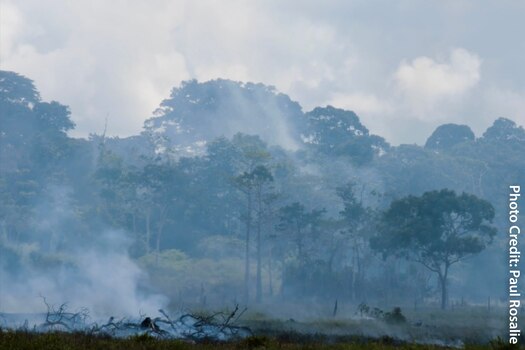Aug. 28, 2019 — The Amazon rainforest fires that have been blazing out of control in Brazil for weeks could have far-reaching effects on our health, experts warn.
More than 26,000 fires have been recorded in the Amazon so far in August, the highest number there in nearly a decade, according to Brazil’s National Institute for Space Research. About 60% of the Amazon, which covers more than 2 million square miles, is in Brazil. Conservationists claim most of the fires have been set intentionally, to clear the land for cattle raising and other purposes
Health and conservation experts say if the fires are not extinguished soon, the Amazon may reach a crucial ”tipping point.” Often called “the planet’s lungs,” the Amazon rainforest is a carbon ”sink,” sucking up carbon dioxide and providing about 20% of the world’s oxygen.
“If we can’t conserve the Amazon, we will lose the fight against the climate crisis,” says Kerry Cesareo, senior vice president for forests for the World Wildlife Fund. “We have already lost about 20% of the rainforest,” she says. According to a 2018 report, the tipping point is 25%.
Paul Rosolie, an author and conservationist, says the fires are throwing off the entire Earth’s climate. “We don’t realize how interconnected everything is. If you were suddenly to turn off the Amazon, our temperatures and rain would change in an instant.” The most tragic part, he says, is that “This is a self-inflicted wound.”
Health Effects, Near and Far
There are immediate impacts from the fires for people living in the area, Cesareo says. About 34 million people live in the Amazon, the World Wildlife Fund estimates, including about 385 groups of indigenous people. Those effects are far-reaching as well:
Air quality: If the forest continues to burn, it will release a vast amount of carbon dioxide pollution into the atmosphere,” says Adrian Forsyth, PhD, co-founder of the Amazon Conservation Association and executive director of the Andes Amazon Fund.
Nighttime levels of particulate matter, small enough to lodge in the lungs, have been found at extremely high levels near the rainforest. “We are talking about concentrations of up to 20 times the EPA standard,” says Douglas Morton, PhD, chief of the Biospheric Sciences Laboratory at NASA’s Goddard Space Flight Center.
Air quality in the U.S. is not expected to be affected, Morton says.
There’s also smoke. “The smoke travels a long way,” Forsyth says, and that’s been true for decades. “Some years you can’t fly into countries like Bolivia. There is so much smoke, it shuts off all the air traffic.” As the smoke accumulated, the Brazilian city of Sao Paulo, with nearly 12 million residents, darkened at 3 p.m. recently, making headlights necessary.
Weather patterns: Rainforests add water to the atmosphere when plants release water from their leaves during photosynthesis. When forests burn, there is less moisture released into the atmosphere, which can mean less rainfall. ”There could be impacts to the rainfall patterns as far away as the U.S.,” Cesareo says.
Medicine: Quinine was the first effective medicine to treat malaria and came from cinchona trees. Many anti-cancer drugs come from rainforest plants. Compounds from rainforest plants are used in drugs to treat high blood pressure, glaucoma, tuberculosis, and other health problems.
Disease: “When forests are cut down, we often see disease outbreaks,” Cesareo says. Researchers have linked the felling of forests to rises in malaria and dengue fever, for instance.
Mental health: “People are messaging me, saying how hopeless they feel as they hear all this news,” Rosolie says. Twitter is overflowing with messages of angst and calls to action, some urging people in expletive-laced tweets to care. Said one: “Everything on Earth is dying, the Amazon forest is burning, everyone is hopeless.” The hashtag #prayforamazonia has sprung up.
The anxiety driven by climate emergencies is a real health issue, Forsyth says. His three children, who hear about conservation regularly and range in age from18 to 21, have begun telling him they have no plans to have children. “They believe the planet is headed to a train wreck,” he says.
Staying Positive, Taking Action
“This is a chronic emergency,” Cesareo says. “Unless there is a change in the enforcement of laws in Brazil, there will continue to be fires set.”
Long-term, says NASA’s Morton, what is needed is ”finding a balance between economic development and conservation.”
“This issue has the ability to unite people,” Rosolie says. “We really can’t afford to look the other way anymore.”
“The good news is, the Amazon is still 80% intact,” Forsyth says. What’s needed, he says, is government enforcement to protect the rainforest.
On a personal level, “we all have to reduce our meat consumption,” says Jos Barlow, PhD, a professor of conservation science at the University of Lancaster in the U.K., who studies the human impact of rainforest fires. “Not all meats are equally bad; chicken is not as bad as beef.”
Voting for public officials devoted to preserving the rainforest can help, he says.
For people feeling doomed or helpless, it’s important to reclaim a sense of control, says Jessy Warner-Cohen, PhD, a senior psychologist at Northwell Health in Lake Success, NY. “A person can choose to make one environmentally friendly change in their life to help offset the impact of this destruction.” For instance, order take-out food one less time per week, as the single-use plastics used in food packaging are an environmental concern. Or volunteer for an environmental group. “Make these goals something that can be accomplished and relevant, and there will often be a decrease in feelings of helplessness.”
By Kathleen Doheny


